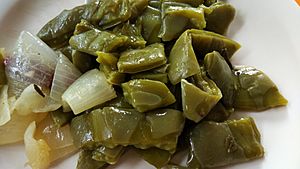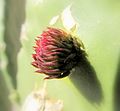Nopal facts for kids
Nopal is a special kind of cactus that people often eat. Its name comes from the Nahuatl language, spoken by the Aztec people. In English, this cactus is usually called the prickly pear.
Nopal refers to the flat, green parts of the cactus, which look like pads. These pads are a popular food, especially in Mexican cuisine. You can eat them raw or cooked. People use them in many dishes like soups, stews, and salads. They are also used in traditional medicine and as food for animals.
There are about 114 different kinds of nopal cactus that grow naturally in Mexico. Most of the nopales grown on farms are from two specific types: Opuntia ficus-indica or Opuntia matudae. However, nearly all types of prickly pear cactus pads are safe to eat.
Besides the pads, the cactus also grows a fruit. This fruit is called tuna in Spanish and "prickly pear" in English.
Nopales are often sold fresh in Mexico. Workers carefully remove the spines, and then the pads are sliced for customers. You can also find them in cans or bottles, often called nopalitos. Sometimes, they are dried for export to other countries.
When cut, nopales have a slightly sour taste, a bit like green beans. They have a crisp texture, but they also contain a slimy liquid. This liquid is usually kept in when cooking. Nopales are best to eat in the spring when they are most tender and juicy.
How Nopal is Used in Cooking
Nopales are a key ingredient in many Mexican dishes. Some popular meals include huevos con nopales (which means "eggs with nopal") and carne con nopales ("meat with nopal"). You might also find them in tacos or in salads with tomato, onion, and queso panela (a type of cheese). Sometimes, they are simply served as a side vegetable.
Nopales have also become important in New Mexican cuisine. They are a part of the food culture for Tejano people in Texas.
Nopal's Health Benefits
Nopal fruit is good for your body. A single serving (about one US cup) gives you a lot of the mineral manganese. It provides 20% of the Daily Value (DV), which is how much you need each day.
It's also a good source of vitamin C (13% DV), magnesium (11% DV), and calcium (14% DV). The older the plant gets, the more nutrients it has. However, some of the calcium in nopal might not be easily absorbed by your body. This is because it's in a form called calcium oxalate.
Nopal and the Economy
The nopal cactus grows all over Mexico. It is especially common in the dry and semi-dry areas in the middle of the country. In Mexico, over 3,000,000 acres of land are used to grow nopal.
Farmers grow nopal in three main ways: on large commercial farms, in smaller family gardens, or by gathering it from the wild. About 57,000 acres are used to grow the prickly pear fruit. Another 10,500 acres are for growing the pads. A smaller area, about 100 acres, is used to produce cochineal, which is a natural dye made from insects that live on the cactus.
In 1996, there were about 10,300 farmers who grew prickly pear fruit. There were also around 8,000 farmers who grew nopal pads. Many people also work in processing industries and in cochineal production. This means that growing nopal provides jobs for a lot of people in Mexico.
Nopal is grown in 18 Mexican states. The Distrito Federal (Mexico City area) grows 74% of the total. Each year, Mexico produces about 58,000 tons of both the fruit and the pads. Growing nopal helps many communities by providing jobs, food, and income. It also allows them to stay living on their land.
In 2006, a cactus-eating moth called Cactoblastis cactorum was found in Mexico. This caused worry among plant health experts. This insect can cause a lot of damage to the cactus industry. Interestingly, in 1925, the same insect was used in Australia to control prickly pear cactus. The cactus had grown too much and become an invasive species there.
Gallery








